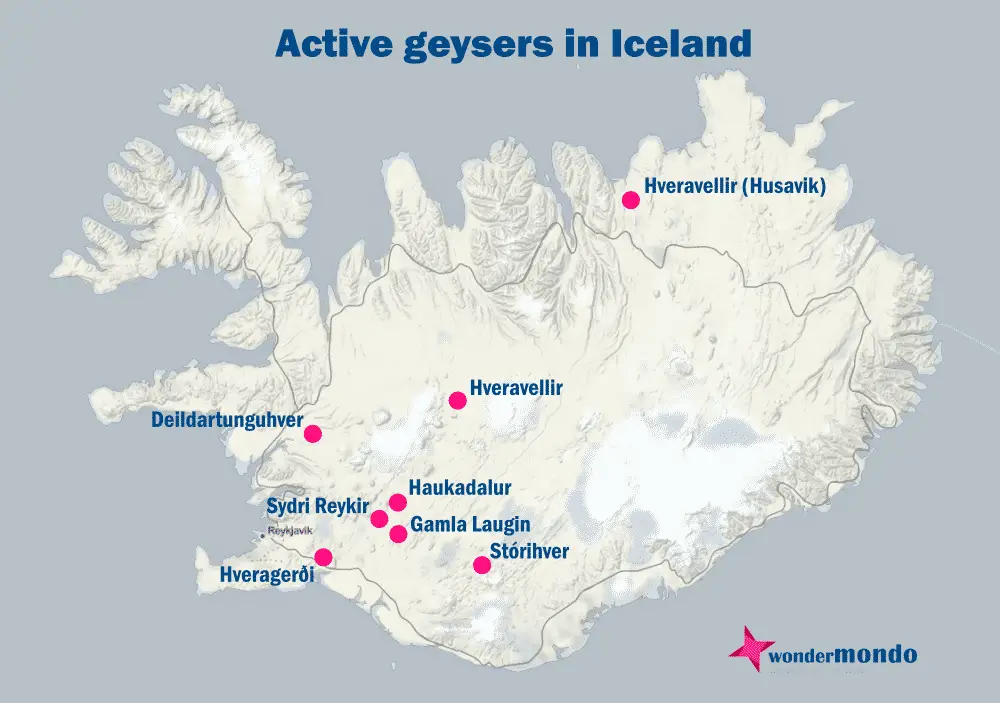Geothermal fields 🢔 Geothermal features 🢔 Geological wonders 🢔 Categories of wonders
Wonder
Gunnuhver geothermal area
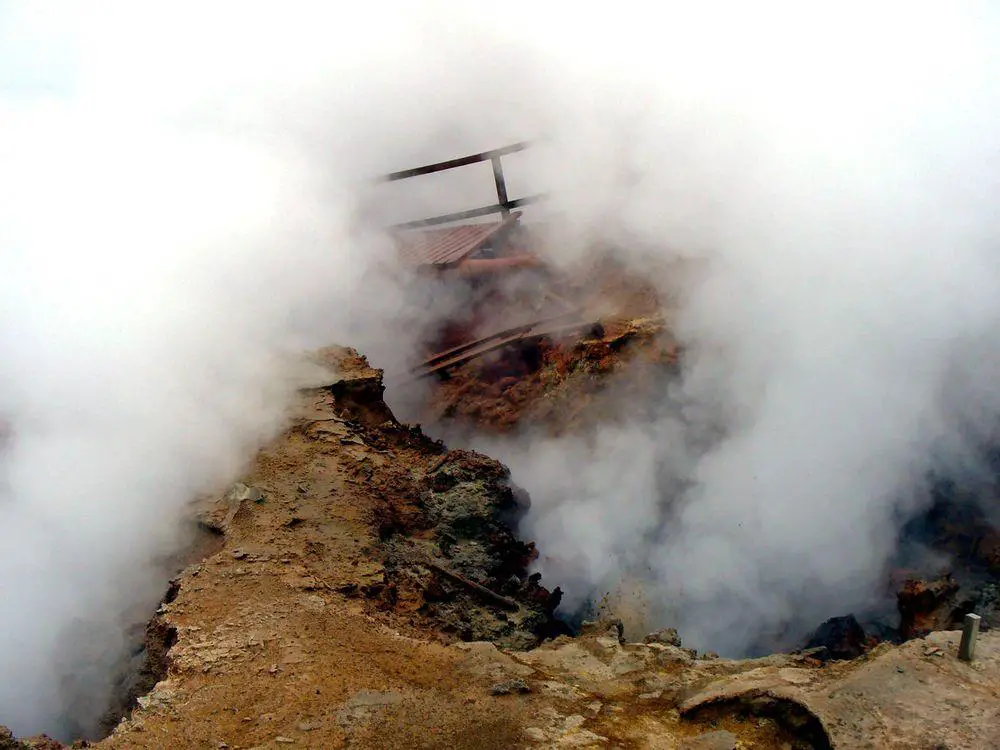
 In short
In short
Nowadays Gunnuhver geothermal area is a field of steaming fumaroles and boiling mud pools. In the recent past here existed some geysers but some four centuries ago this area was… heavily haunted.
 48.8%
48.8%
GPS coordinates
Map of the site
If you see this after your page is loaded completely, leafletJS files are missing.
 In detail
In detail
Border between Europe and North America
Iceland is a place, where the land is born. Tectonic plates slowly shift to the west and to the east and in between a new, hot ground with gases and liquids rises from the entrails of Earth.
Reykjanes peninsula is one of the best places to see this – the continental divide in some places looks exactly like a divide – a steaming ground between two high "banks" of a bit older ground.
Mud pools and steam vents
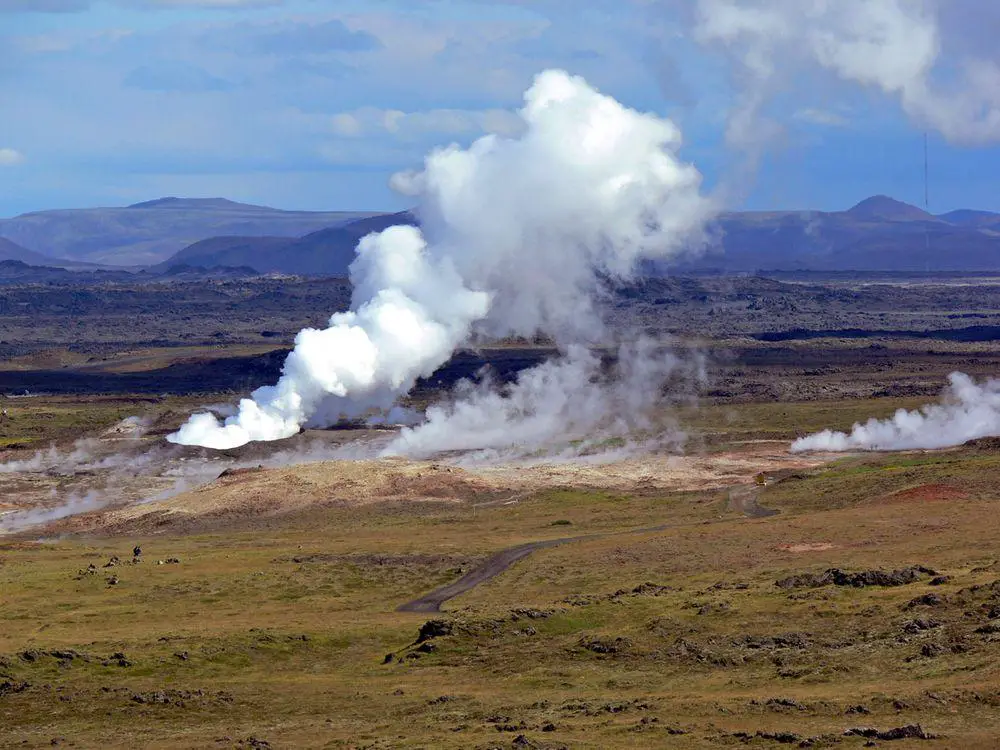
As the tectonic plates move, new passages are constantly opening (and older ones are closing) for heated groundwater and gases.
Gunnuhver is one such area. Here deeper below the surface the temperature of ground (and water in it) reaches 300° C. Much of groundwater comes from the nearby sea and is rich with chlorides and also with dissolved silica.
As a result in the recent past hot springs and geysers have created sinter deposits – a hill named Kísilhóll (Kísilhóll, Silica hill).
Today here are no hot water springs and geysers, but northeast from Kísilhóll are located many steam vents (fumaroles) and boiling mud pools. Mud pools are formed by acidic groundwater sources, which turn lava into clay.
The largest mud pool in Iceland also is located here – it is 20 m across, boiling vigorously along its rims.
Hot ground is an immense source of energy. In 2006 near Gunnuhver geothermal field started to operate the Reykjanes Geothermal Plant. As a result the steaming of the ground in the geothermal field increased.
Geysers and earthquakes
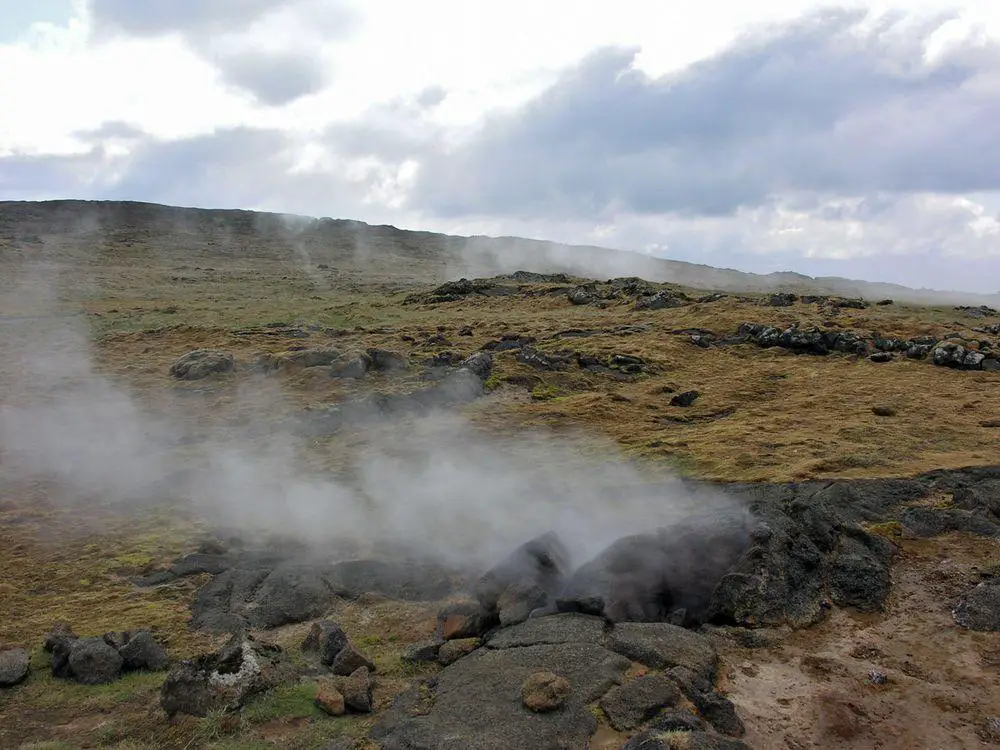
Earthquakes are very common in Reykjanes peninsula – but for the most part, they are weak. Sometimes though happen stronger ones, which manage to make some new cracks and faults in deeper rocks. Then seawater enters these fissures, gets heated, and sometimes there forms hot springs and geysers on the land surface.
Geysers in Gunnuhver formed in a such way in 1919 and around 1970. But, it seems, the ground here is too weak to sustain geysers for a longer time. The "old geyser of Gunnuhver" (which formed in 1919) existed for some 80 years and was the last one – it blew itself to pieces at the end of the 20th or early 21st century.
It is very possible that new geysers will be created by earthquakes in future.
And now: a ghost story in three parts!

The name Gunnuhver means "Gunns fumarole / hot spring" (not exactly "Gunns geyser" as often is mentioned in tourist literature). The origin of this name is exotic, to say the least.
Part 1. Cooking pot of inconceivable importance
Guðrún (nicknamed Gunn) was an old witch (you will see – she was a true witch!) and she came in grips with a man in her neighborhoods – a judge Vilhjálmur. Who knows how it started, but a cooking pot certainly was involved in this feud. Vilhjálmur took this magnificent home utensil from Guðrún as a payment for a debt and Guðrún foamed with rage about this: she swore that she will find a way to revenge.
Part 2. Sweet and ghastly revenge
One day Guðrún died.
Vilhjálmur arrived at her funeral. In the evening he headed home… and the next day was found dead in Reykjanes. His body was distorted and bruised.
There were no doubts – this was the revenge performed by a ghost of Guðrún – according to locals she managed to turn into a true draug – a terrible, powerful specter.
Draugs in general are more related to deceased Vikings and seamen but sometimes other powerful apparitions also are named draug.
Body of the poor judge was taken home and a local pastor was guarding it. Ghost really tried to take the body and the pastor spent a terrible night, holding the ghost away from the body.
Ghost of Gunn did not calm down after the death of Vilhjálmur. It became more and more powerful. Soon after died the widow of Vilhjálmur – local people were blaming the ghost for it.
The terrible draug of Reykjanes caused a great disturbance in the whole area. People got lost, many experienced weird accidents, and quite a few even saw the ghost.
Part 3. Good use is found for mud pots, fumaroles (and brennivín too)
People of Reykjanes were in despair and needed help.
There was a pastor in Vogsósar – Eiríkur Magnússon – who was a well-known sorcerer. He knew well how to handle such terrible specters. But, as a Christian clergyman, he was not too happy to enter into such adventures.
He had a weakness – he loved brennivín a bit too much. This was used by the victims of Gunn.
One day six men from Reykjanes arrived at the house of Eiríkur and kindly asked for his assistance. Rich supplies of brennivín were added as a conclusive argument.
This worked true miracles. Eiríkur did not come himself – he just gave a ball of yarn and told: villagers should give the end of the thread into the hands of draug. The ball itself would take the specter to a safe place without an exit.
The men from Reykjanes returned home and did, as they were told.
Gunn indeed took the end of the thread – and the ball miraculously started to roll and pulled her with it. Finally, the ball fell into a large fumarole and the ghost followed it.
Some tell though that the ghost was not dragged in the fumarole. The terrible draug reportedly is attached to the short thread and is crouching around the fumarole, unable to escape and not willing to jump in it.
Since then this terrible ghost does no harm but the fumarole got its name.
References
- Bibliophile, Friday night folk-tale: Gunna’s Fumarole, Reading in Reykjavík. Accessed on the August 7, 2011.
Gunnuhver geothermal area is included in the following article:
 Linked articles
Linked articles
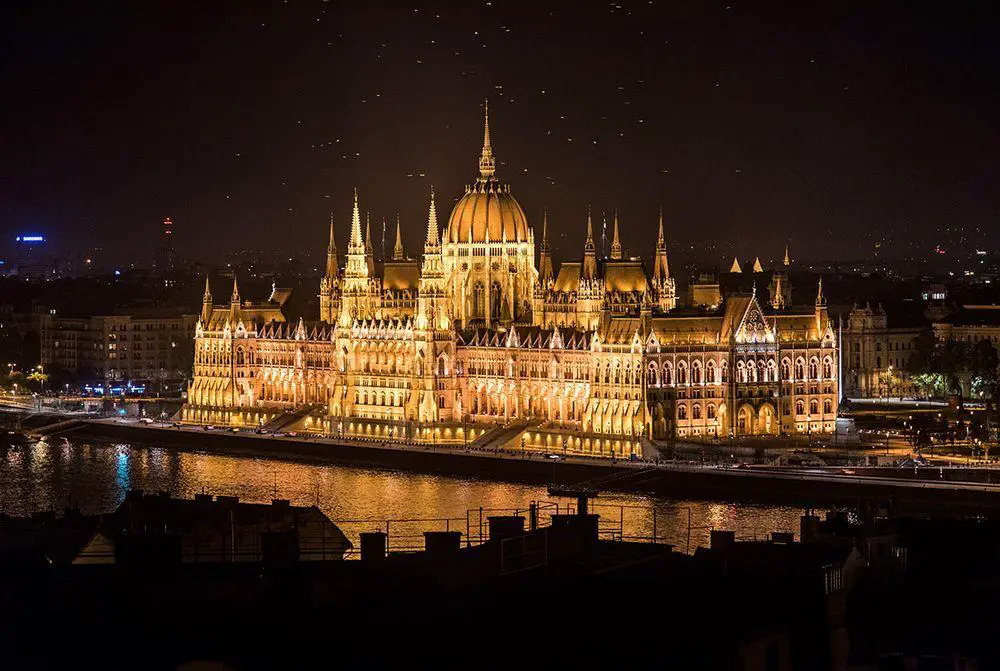
Wonders of Europe
The heritage of Europe is diverse and endlessly interesting. Incomparably rich is the wealth of European historical architecture, but this part of the world has exciting natural heritage and archaeological heritage as well.
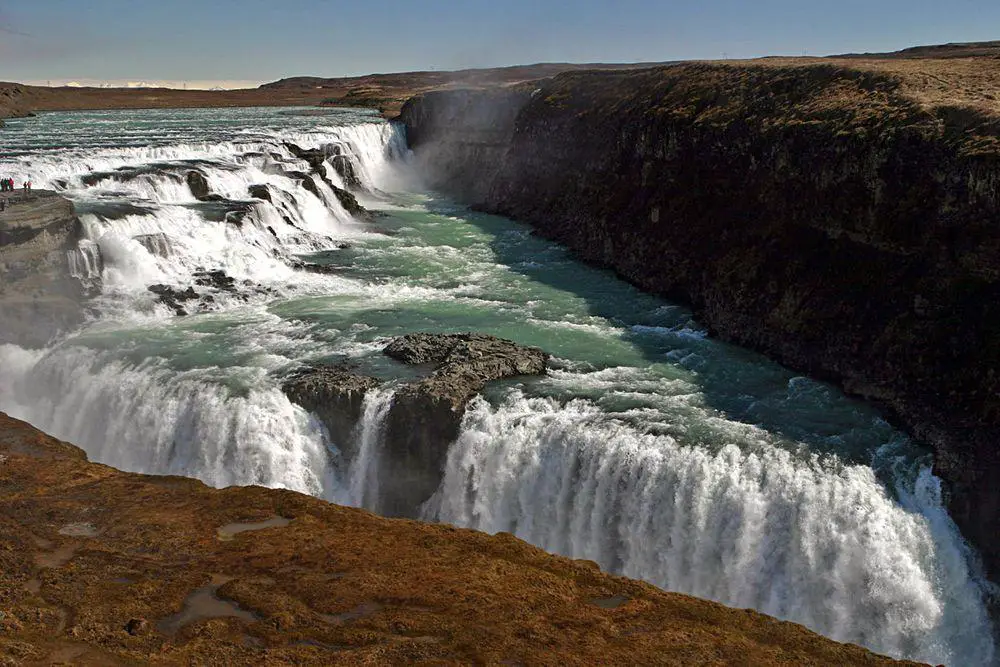
Wonders of Iceland
Iceland is very rich with peculiar natural landmarks and the island contains also interesting cultural landmarks. The highlights of Iceland are the magnificent waterfalls as well as geysers and other geothermal features.
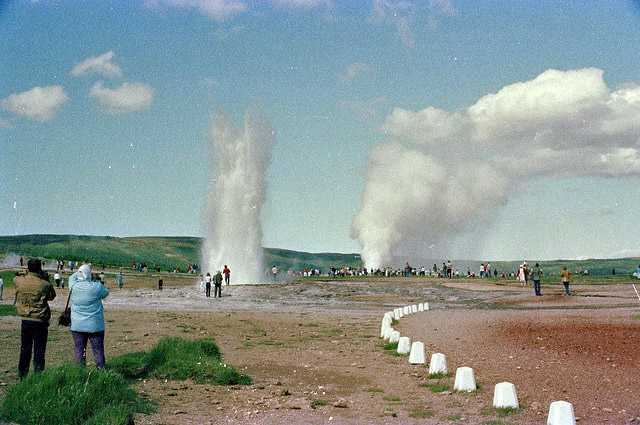
Geysers
Hasty hydrogeologists would say: geysers are thermodynamically and hydrodynamically unstable hot springs. “Normal” people would say – geysers are hot springs that at more or less regular intervals shoot up a fountain of boiling water and steam. Sometimes these fountains are even 100 m tall… or even 450 m!
 Recommended books
Recommended books
Iceland Travel Guide
Iceland Travel Guide Introduction This book includes all the necessary links for an easy journey to your Icelandic adventure. To make your Iceland travel more entertaining and full of all of the things that you want, you’ll see a step-by-step route around the entire country, indicating the distance in miles, accommodations, recreation, entertainment, shopping, and much more. This Iceland travel guide will be the perfect companion to see all of the hottest spots, like Blue Lagoon, Iceland, and other must-sees.
The Glorious Geology of Iceland’s Golden Circle
This is the first book describing the glorious geology of Iceland’s Golden Circle and four additional excursions:(1) the beautiful valleys and mountains of the fjord of Hvalfjördur, (2) the unique landscape and geothermal fields of the Hengill Volcano, (3) the explosion craters, volcanic fissures, and lava fields of the Reykjanes Peninsula, and (4) the volcanoes (Hekla, Eyjafjallajökull, Katla), waterfalls, sandur plains, and rock columns of South Iceland. The Golden Circle offers a unique opportunity to observe and understand many of our planet’s forces in action.

